The Unexploited Potential of Converting Rail Tracks to Greenways: The Spanish Vías Verdes
Abstract
1. Introduction
2. Literature Review
3. The European and Spanish Context: Rail-Trails as a Special Type of Greenway
3.1. Spanish Vías Verdes, a Successful Leisure Infrastructure
3.2. Vías Verdes in the Spanish Mediterranean Arc
4. Selected Case Studies: Girona and Alicante Provinces
4.1. Girona: A Poly-Nuclear Connectivity Following the Vías Verdes’ Routes
4.2. Alicante: Multi-Landscape Scenery in a Fragmented Network
5. Discussion
6. Conclusions
Author Contributions
Acknowledgments
Conflicts of Interest
References
- Martí-Henneberg, J. European integration and national models for railway networks (1840-2010). J. Transp. Geogr. 2013, 26, 126–138. [Google Scholar] [CrossRef]
- Williamson, K.S. Growing with Green Infrastructure; Heritage Conservancy: Doylestown, PA, USA, 2003. [Google Scholar]
- RENFE-ADIF. Fundación de los Ferrocarriles Españoles. Available online: https://www.ffe.es/ (accessed on 17 January 2019).
- Aycart Luengo, C. Vías verdes: La experiencia española. El proyecto Rever. Rev. Ing. y Territ. 2004, 69, 28–37. [Google Scholar]
- Bartoschek, A. Ex ferrovie recuperate all’uso ciclistico in Europa. In Dalle Rotaie Alle Bici. Indagine Sulle Ferrovie Dismesse, Recuperate All’uso Ciclistico; Cortesi, G., Rovaldi, U., Eds.; Federacione Italiana Amici della Bicicletta (FIAB) - Centrostudi Gallimbeni: Milano, Italy, 2011; pp. 25–37. [Google Scholar]
- Llausàs, A.; Roe, M. Green Infrastructure Planning: Cross-National Analysis between the North East of England (UK) and Catalonia (Spain). Eur. Plan. Stud. 2012, 20, 641–663. [Google Scholar] [CrossRef]
- Minor, E.S.; Anderson, E.C.; Belaire, J.A.; Garfinkel, M.; Smith, A.D. Urban Green Infrastructures and Ecological Networks for Urban Biodiversity Conservation. In Urban Biodiversity; Routledge: Abingdon, UK, 2018; pp. 186–199. [Google Scholar]
- Ossola, A.; Niemelä, J. Urban Biodiversity: From Research to Practice; Routledge: Abingdon, UK, 2017. [Google Scholar]
- Tian, Y.; Liu, Y.; Jim, C.; Song, H. Assessing Structural Connectivity of Urban Green Spaces in Metropolitan Hong Kong. Sustainability 2017, 9, 1653. [Google Scholar] [CrossRef]
- Artmann, M.; Bastian, O.; Grunewald, K. Using the Concepts of Green Infrastructure and Ecosystem Services to Specify Leitbilder for Compact and Green Cities—The Example of the Landscape Plan of Dresden (Germany). Sustainability 2017, 9, 198. [Google Scholar] [CrossRef]
- Kohler, M.; Meinel, G.; Gan, J.; Ioja, I.C. How smart growth and green infrastructure can mutually support each other — A conceptual framework for compact and green cities. Ecol. Indic. 2019, 96, 10–22. [Google Scholar]
- Benedict, M.A.; McMahon, E.; The Conservation Fund. Green Infrastructure: Linking Landscapes and Communities; Island Press: Washington, DC, USA, 2006. [Google Scholar]
- Dige, G.; Liquete, C.; Kleeschulte, S.; Banko, G. Spatial analysis of green infrastructure in Europe. EEA Technical report. 2014. Available online: https://www.eea.europa.eu/publications/spatial-analysis-of-green-infrastructure (accessed on 2 September 2019).
- European Commission Green Infrastructure (GI) — Enhancing Europe’s Natural Capital. 2013. Available online: https://eur-lex.europa.eu/legal-content/EN/TXT/?uri=CELEX:52013DC0249 (accessed on 2 September 2019).
- Rails-to-Trails Conservancy (RTC). USA - Rails-to-Trails Conservancy Website. Available online: http://www.railstotrails.org/about/ (accessed on 2 September 2019).
- AEVV-EGWA. European Greenways Association website. Available online: http://www.aevv-egwa.org/ (accessed on 2 September 2019).
- Kaloyanov, K. Cycling Tourism Routes as an Instrument for Regional Development and Transnational Cooperation within the Lower Basin of the Danube River. Bulg. Acad. Sci. Probl. Geogr. 2016, 3-4, 139–149. [Google Scholar]
- Ministerio para la Transición Ecológica (MITECO). Mapa Forestal de España (MFE50). Available online: https://www.miteco.gob.es/es/biodiversidad/servicios/banco-datos-naturaleza/informacion-disponible/mfe50.aspx (accessed on 2 September 2019).
- Instituto Nacional de Estadistica (Spanish Statistical Office). Available online: https://www.ine.es/ (accessed on 18 January 2019).
- Whyte, W.H. Securing Open Space for Urban America: Conservation Easements; Urban Land Institute: Washington, DC, USA, 1959. [Google Scholar]
- Bischoff, A. Greenways as vehicles for expression. Landsc. Urban Plan. 1995, 33, 317–325. [Google Scholar] [CrossRef]
- Ahern, J.; Fabos, J.G. Greenways as a planning strategy. Landsc. Urban Plan. 1995, 33, 131–155. [Google Scholar] [CrossRef]
- Little, C.E. Greenways for America; Johns Hopkins University Press: Baltimore, MD, USA, 1990. [Google Scholar]
- Smith, D.S.; Hellmund, P.C. Ecology of Greenways: Design and Function of Linear Conservation Areas; University of Minnesota Press: Minneapolis, MN, USA, 1993. [Google Scholar]
- Searns, R.M. The evolution of greenways as an adaptive urban landscape form. Landsc. Urban Plan. 1995, 33, 65–80. [Google Scholar] [CrossRef]
- Ahern, J.; Fabos, J.G. Greenways. Landsc. Urban Plan. 1995. Available online: https://www.sciencedirect.com/journal/landscape-and-urban-planning/vol/33/issue/1 (accessed on 18 January 2019).
- Fabos, J.G. Introduction and overview: The greenway movement, uses and potentials of greenways. Landsc. Urban Plan. 1995, 33, 1–13. [Google Scholar] [CrossRef]
- Walmsley, A. Greenways and the making of urban form. Landsc. Urban Plan. 1995, 33, 81–127. [Google Scholar] [CrossRef]
- Qian, J.; Xiang, W.N.; Liu, Y.; Meng, X. Incorporating landscape diversity into greenway alignment planning. Urban For. Urban Green. 2018, 35, 45–56. [Google Scholar] [CrossRef]
- Yu, K.; Li, D.; Li, N. The evolution of Greenways in China. Landsc. Urban Plan. 2006, 76, 223–239. [Google Scholar] [CrossRef]
- Ndubisi, F.; DeMeo, T.; Ditto, N.D. Environmentally sensitive areas: A template for developing greenway corridors. Landsc. Urban Plan. 1995, 33, 159–177. [Google Scholar] [CrossRef]
- Bryant, M.M. Urban landscape conservation and the role of ecological greenways at local and metropolitan scales. Landsc. Urban Plan. 2006, 76, 23–44. [Google Scholar] [CrossRef]
- Von Haaren, C.; Reich, M. The German way to greenways and habitat networks. Landsc. Urban Plan. 2006, 76, 7–22. [Google Scholar] [CrossRef]
- Flink, C.A.; Olka, K.; Searns, R.M.; Rails-to-Trails Conservancy. Trails for the Twenty-First Century: Planning, Design, and Management Manual for Multi-Use Trails; Island Press: Washington, DC, USA, 2001. [Google Scholar]
- Flink, C.A.; Searns, R.M. Greenways: A Guide to Planning, Design, And Development, 1st ed.; Island Press: Washington, DC, USA, 1993. [Google Scholar]
- Palardy, N.P.; Boley, B.B.; Johnson Gaither, C. Residents and urban greenways: Modeling support for the Atlanta BeltLine. Landsc. Urban Plan. 2018, 169, 250–259. [Google Scholar] [CrossRef]
- Zhao, F.; Nie, R.; Zhang, J. Greenway Implementation Influence on Agricultural Heritage Sites (AHS): The Case of Liantang Village of Zengcheng District, Guangzhou City, China. Sustainability 2018, 10, 434. [Google Scholar] [CrossRef]
- Ribeiro, L.; Barão, T. Greenways for recreation and maintenance of landscape quality: Five case studies in Portugal. Landsc. Urban Plan. 2006, 76, 79–97. [Google Scholar] [CrossRef]
- Hoover, A.P.; Shannon, M.A. Building greenway policies within a participatory democracy framework. Landsc. Urban Plan. 1995, 33, 433–459. [Google Scholar] [CrossRef]
- Bischoff, A. Author Index. Landsc. Urban Plan. 1995, 33, 481–482. [Google Scholar]
- Liu, Z.; Lin, Y.; De Meulder, B.; Wang, S. Can greenways perform as a new planning strategy in the Pearl River Delta, China? Landsc. Urban Plan. 2019, 187, 81–95. [Google Scholar] [CrossRef]
- Hague, C.; Jenkins, P. Place Identity, Participation and Planning; Routledge: Abingdon, UK, 2005. [Google Scholar]
- Siderelis, C.; Moore, R. Outdoor Recreation Net Benefits of Rail-Trails. J. Leis. Res. 1995, 27, 344–359. [Google Scholar] [CrossRef]
- Di Marino, M.; Tiitu, M.; Lapintie, K.; Viinikka, A.; Kopperoinen, L. Integrating green infrastructure and ecosystem services in land use planning. Results from two Finnish case studies. Land Use Policy 2019, 82, 643–656. [Google Scholar] [CrossRef]
- Davies, C.; MacFarlane, R.; McGloin, C.; Roe, M. Green Infrastructure Planning Guide; North-East Community Forests: Durham, UK, 2006. [Google Scholar]
- Mell, I.C. Can green infrastructure promote urban sustainability? Eng. Sustain. 2009, 162, 23–34. [Google Scholar] [CrossRef]
- Linehan, J.; Gross, M.; Finn, J. Greenway planning: Developing a landscape ecological network approach. Landsc. Urban Plan. 1995, 33, 179–193. [Google Scholar] [CrossRef]
- Girardet, H. Regenerative Cities. In Green Economy Reader; Springer International Publishing: Cham, Switzerland, 2017; pp. 183–204. [Google Scholar]
- Tzoulas, K.; Korpela, K.; Venn, S.; Yli-Pelkonen, V.; Kaźmierczak, A.; Niemela, J.; James, P. Promoting ecosystem and human health in urban areas using Green Infrastructure: A literature review. Landsc. Urban Plan. 2007, 81, 167–178. [Google Scholar] [CrossRef]
- Elmqvist, T.; Setälä, H.; Handel, S.N.; van der Ploeg, S.; Aronson, J.; Blignaut, J.N.; Gómez-Baggethun, E.; Nowak, D.J.; Kronenberg, J.; de Groot, R. Benefits of restoring ecosystem services in urban areas. Curr. Opin. Environ. Sustain. 2015, 14, 101–108. [Google Scholar] [CrossRef]
- Gómez-Baggethun, E.; Barton, D.N. Classifying and valuing ecosystem services for urban planning. Ecol. Econ. 2013, 86, 235–245. [Google Scholar] [CrossRef]
- Martín-López, B.; Iniesta-Arandia, I.; García-Llorente, M.; Palomo, I.; Casado-Arzuaga, I.; Del Amo, D.G.; Gómez-Baggethun, E.; Oteros-Rozas, E.; Palacios-Agundez, I.; Willaarts, B.; et al. Uncovering Ecosystem Service Bundles through Social Preferences. PLoS ONE 2012, 7, e38970. [Google Scholar] [CrossRef] [PubMed]
- Larson, L.R.; Keith, S.J.; Fernandez, M.; Hallo, J.C.; Shafer, C.S.; Jennings, V. Ecosystem services and urban greenways: What’s the public’s perspective? Ecosyst. Serv. 2016, 22, 111–116. [Google Scholar] [CrossRef]
- Rolf, W.; Peters, D.; Lenz, R.; Pauleit, S. Farmland—An Elephant in the Room of Urban Green Infrastructure? Lessons learned from connectivity analysis in three German cities. Ecol. Indic. 2018, 94, 151–163. [Google Scholar] [CrossRef]
- Moore, R.L.; Graefe, A.R. Attachments to recreation settings: The case of rail-trail users. Leis. Sci. 1994, 16, 17–31. [Google Scholar] [CrossRef]
- Reis, A.C.; Jellum, C. Rail Trail Development: A Conceptual Model for Sustainable Tourism. Tour. Plan. Dev. 2012, 9, 133–147. [Google Scholar] [CrossRef]
- Fundación Ferrocarriles Españoles. Estudio sobre el nivel de uso e impacto socioeconómico de los caminos naturales y vías verdes españolas incluidas en el Programa Nacional de desarrollo rural; Ministerio de Agricultura, Pesca y Alimentación: Madrid, Spain, 2019.
- Delgado Hernández, L.; Carpio Pinedo, R.; Delgado Hernández, L.; Delgado Ruiz, M.A.; García Pastor, A. Intermodality: Bikes, Greenways and Public Transport. Best Practices Guide; Consorcio Regional de Transportes de Madrid-CRTM: Madrid, Spain, 2014. [Google Scholar]
- Hernandez Colorado, A.; Aizpurúa Giraldez, N.; Aycart Luengo, C. Desarrollo sostenible y empleo en las Vías Verdes; Fundación de los Ferrocarriles Españoles: Madrid, Spain, 2011. [Google Scholar]
- Ferretti, V.; Degioanni, A. How to support the design and evaluation of redevelopment projects for disused railways? A methodological proposal and key lessons learned. Transp. Res. Part D Transp. Environ. 2017, 52, 29–48. [Google Scholar] [CrossRef]
- Guerrieri, M.; Ticali, D. Design standards for converting disused railway lines into Greenways. In Proceedings of the International Conference on Sustainable Design and Construction (ICSDC) 2011, Kansas City, MO, USA, 23–25 March 2011; pp. 375–383. [Google Scholar]
- Aycart Luengo, C. Vias Verdes ‘Greenways’, to reuse disused rail-ways line for non motorised itineraries, leisure and tourism. Inf. la Constr. 2001, 53, 17–29. [Google Scholar] [CrossRef]
- Aycart Luengo, C. Vías verdes: Las pioneras. Ambient. la Rev. del Minist. Medio Ambient. 2007, 65, 32–38. [Google Scholar]
- Bartoschek, A. Bahntrassenradeln - Verzeichnis der Bahntrassenwege [Achim Bartoschek]. Available online: http://www.bahntrassenradeln.de/ (accessed on 17 January 2019).
- Gobierno de España Ministerio de Fomento. Ferroviario. Available online: https://www.fomento.gob.es/ferroviario (accessed on 18 January 2019).
- Ministerio para la Transición Ecológica (MITECO). Red Natura 2000 (RN2000). Available online: https://www.miteco.gob.es/es/cartografia-y-sig/ide/descargas/biodiversidad/rn2000.aspx (accessed on 17 January 2019).
- Rueda, S. Guía Metodológica para los Sistemas de Auditoría, Certificación o Acreditación de la Calidad en el Medio Urbano; Ministerio de Fomento: Madrid, Spain, 2012.
- Pozueta, J.; Lamíquiz Daudén, J.; Porto Schettino, M. La ciudad Paseable: Recomendaciones para la Consideración de los Peatones en el Planeamiento, el Diseño Urbano y la Arquitectura, 2nd ed.; Ministerio de Fomento: Madrid, Spain, 2013.
- Nogue, J.; Sala, P. Cataleg de Paisatge de les Comarques Gironines; Generalitat de Catalunya: Girona, Spain, 2010.
- Manton, R.; Hynes, S.; Clifford, E. Greenways as a tourism resource: A study of user spending and value. Tour. Plan. Dev. 2016, 13, 427–448. [Google Scholar] [CrossRef]
- Shafer, C.S.; Lee, B.K.; Turner, S. A tale of three greenway trails: User perceptions related to quality of life. Landsc. Urban Plan. 2000, 49, 163–178. [Google Scholar] [CrossRef]
- Ajuntament de Girona. Sostenibilitat. Projecte ‘la Vora’ de Girona. Available online: http://www2.girona.cat/ca/sostenibilitat/lavora (accessed on 18 January 2019).
- Franch Batllorí, M. Las veras de Girona. Laboratorio de diseño y gestión para una Infraestructura Verde Urbana en Girona | Girona’s shores. Design and management laboratory for Green Urban Infrastructure in Girona. Zarch 2016, 7, 10–43. [Google Scholar] [CrossRef][Green Version]
- Generalitat Valenciana. Plan de Infraestructura Verde y Paisaje de la Comunitat Valenciana. Available online: http://www.upv.es/contenidos/CAMUNISO/info/778623normalc.html (accessed on 18 January 2019).
- Meseguer Colomina, R.M.G. La problemática de las vías verdes. Metodología de intervención y aplicación al caso práctico de la vía verde de la “Xixarra”. Master’s Thesis, Universidad Politécnica de Valencia, Valencia, Spain, September 2016. [Google Scholar]
- Ramot, J. Wikiloc - Rutas del Mundo. Available online: https://es.wikiloc.com/ (accessed on 22 November 2019).
- Top rutas de senderismo en Comunidad Valenciana (España) | Wikiloc. Available online: https://es.wikiloc.com/rutas/senderismo/espana/comunidad-valenciana (accessed on 22 November 2019).
- Top rutas en Catalunya (España) | Wikiloc. Available online: https://es.wikiloc.com/rutas/outdoor/espana/catalunya (accessed on 22 November 2019).
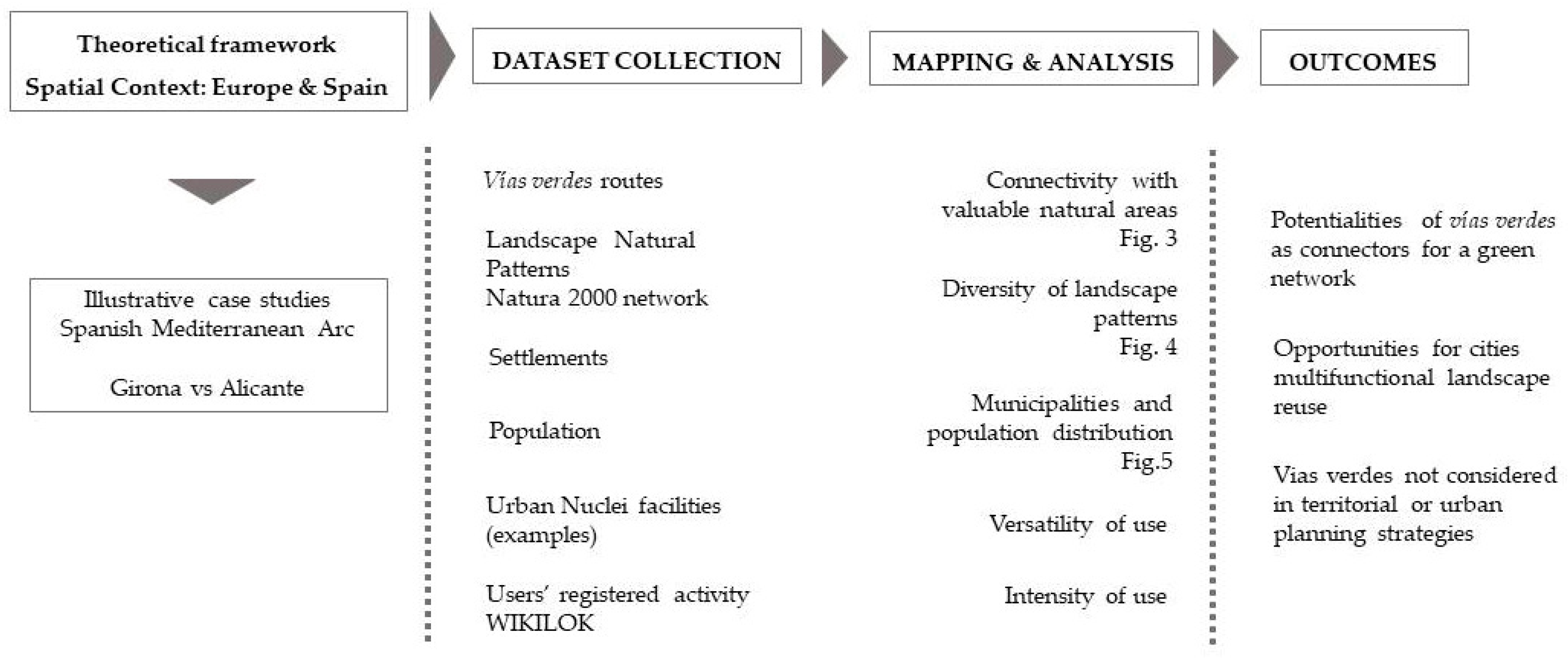
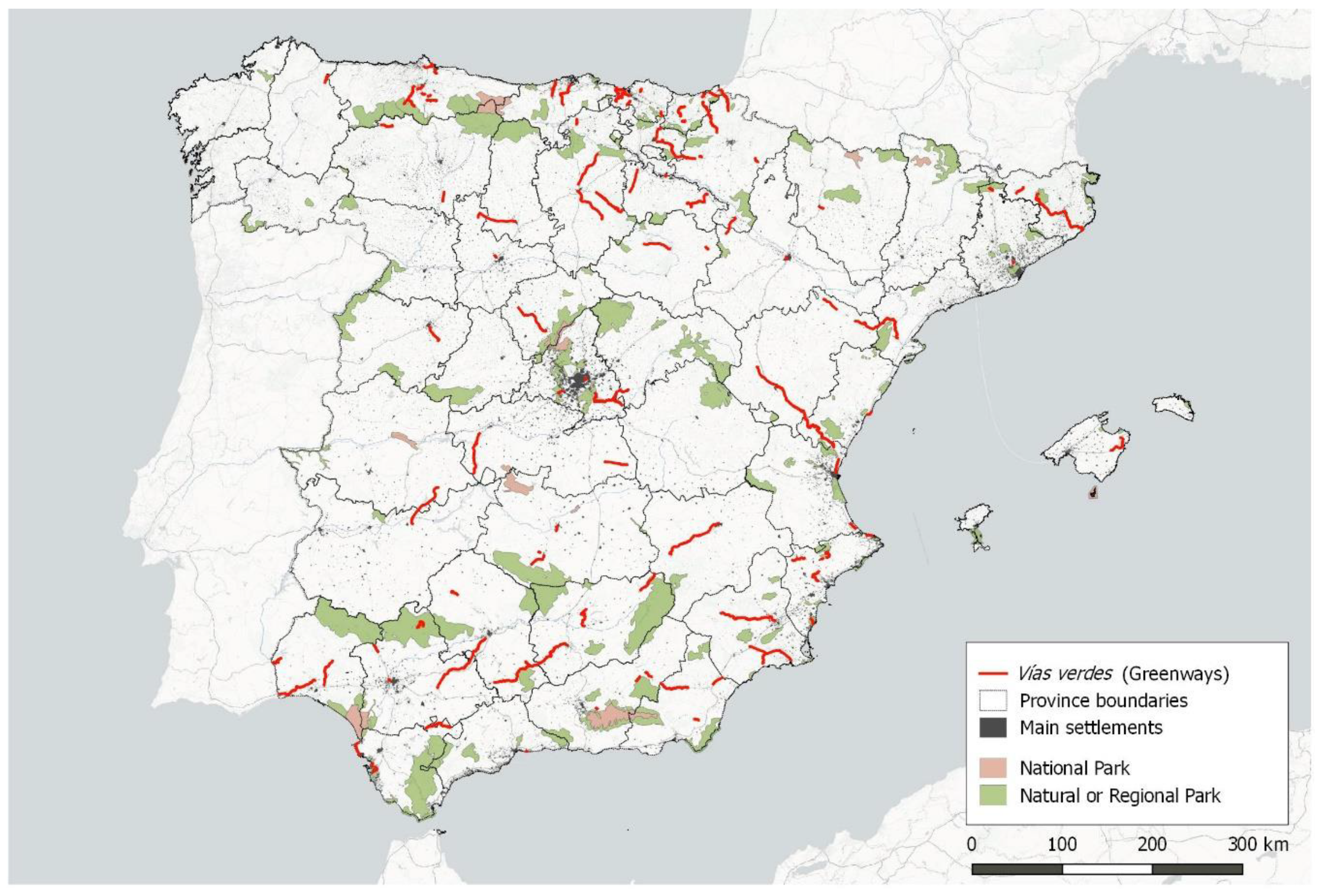


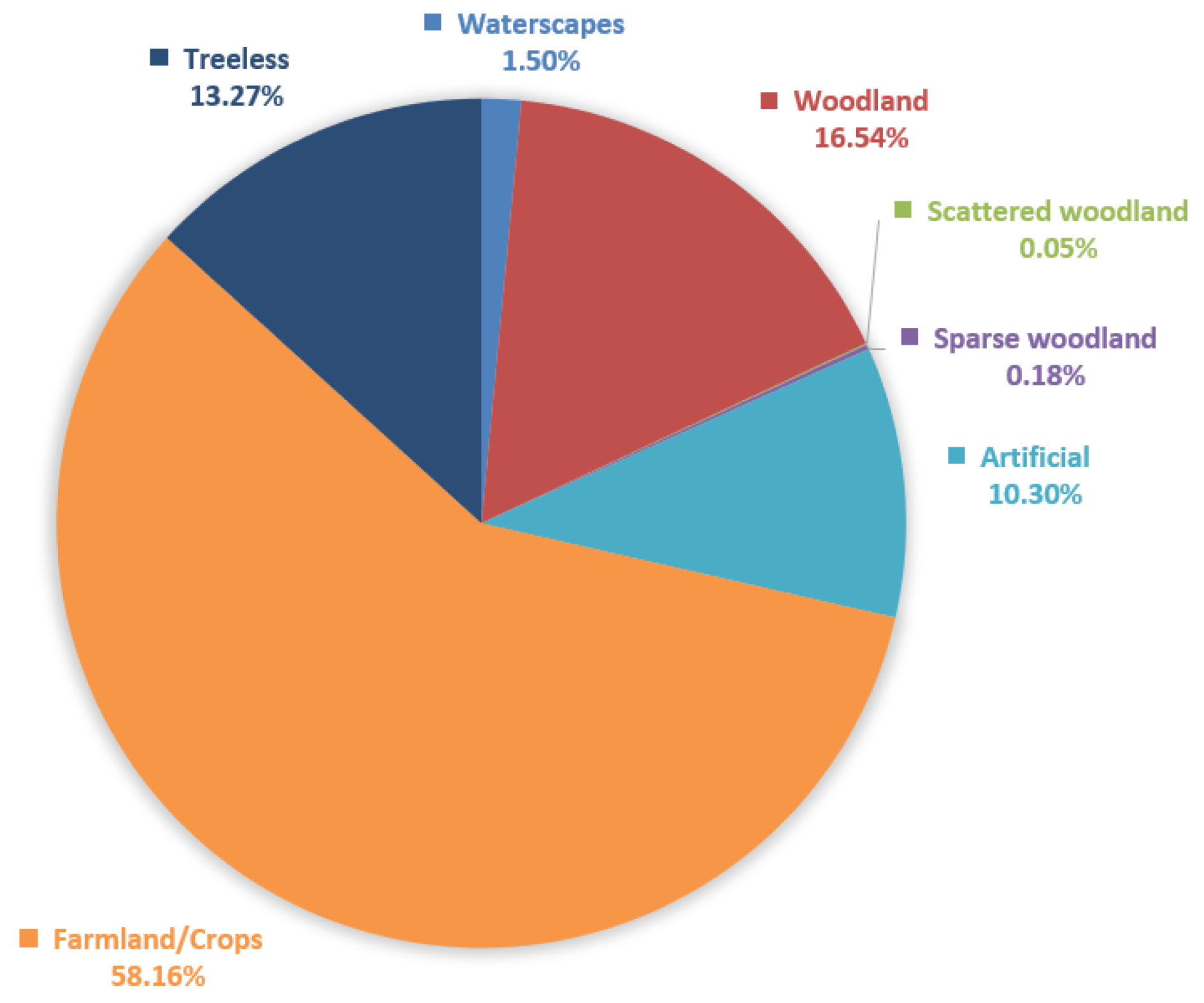

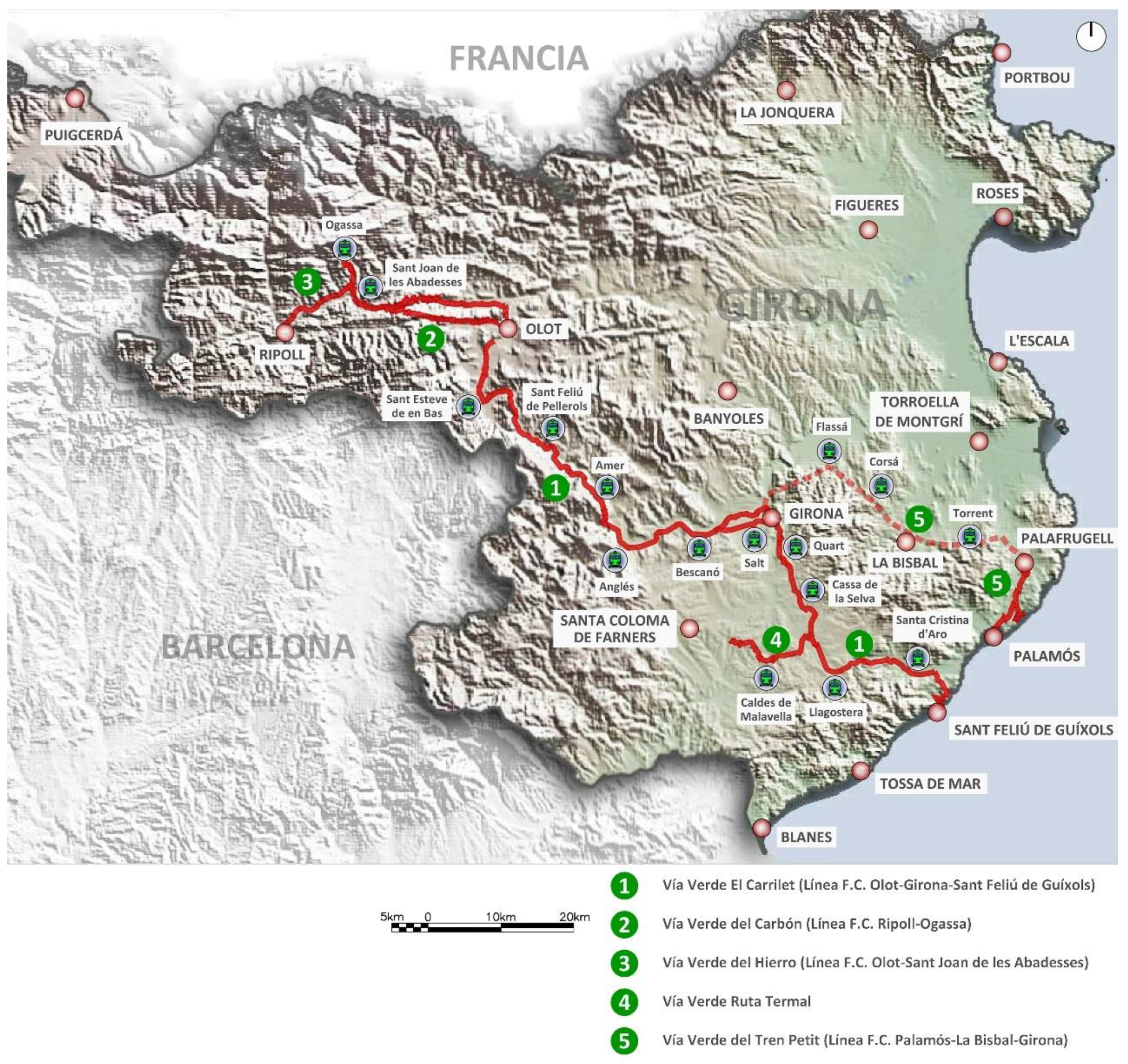
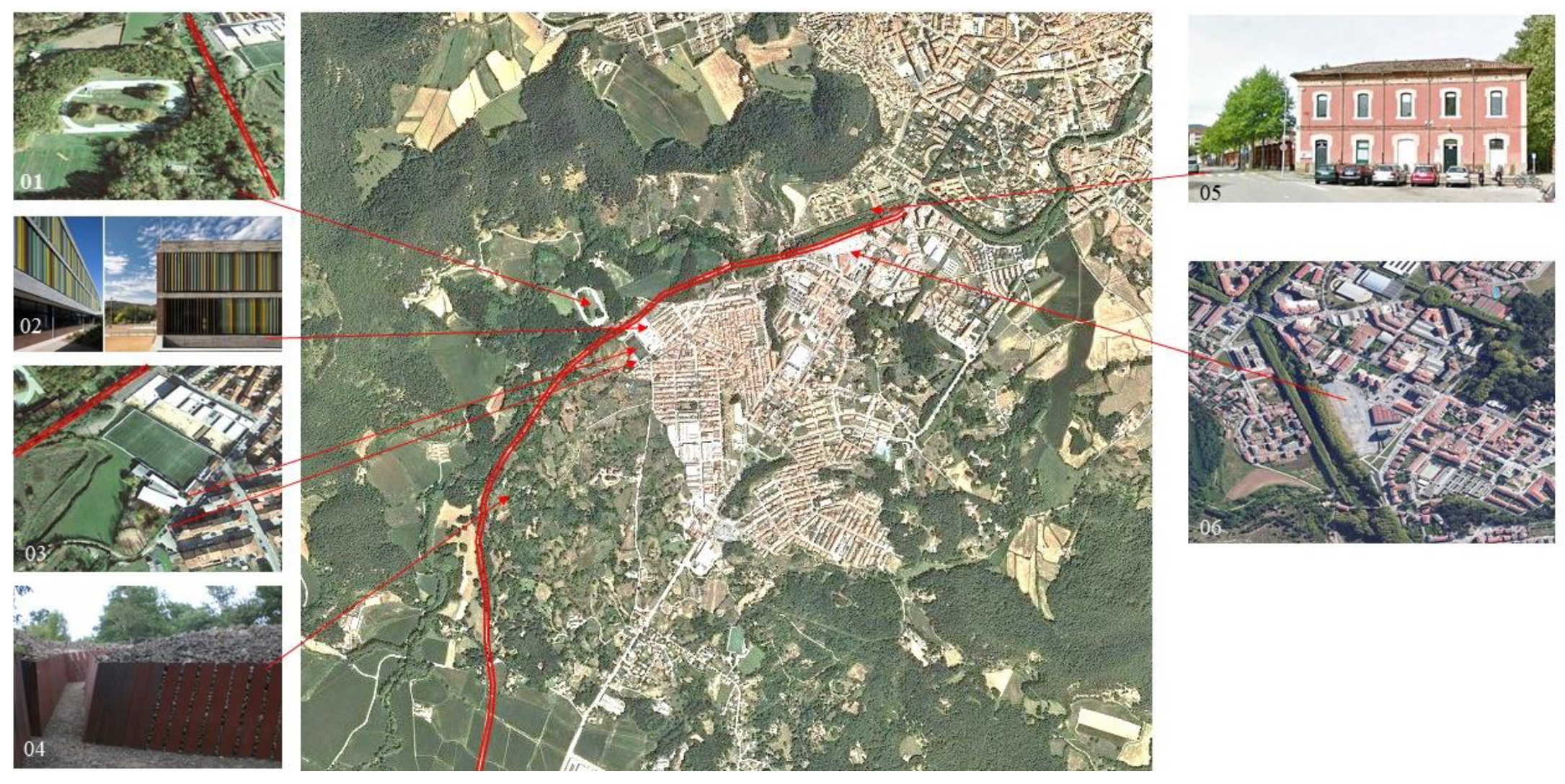
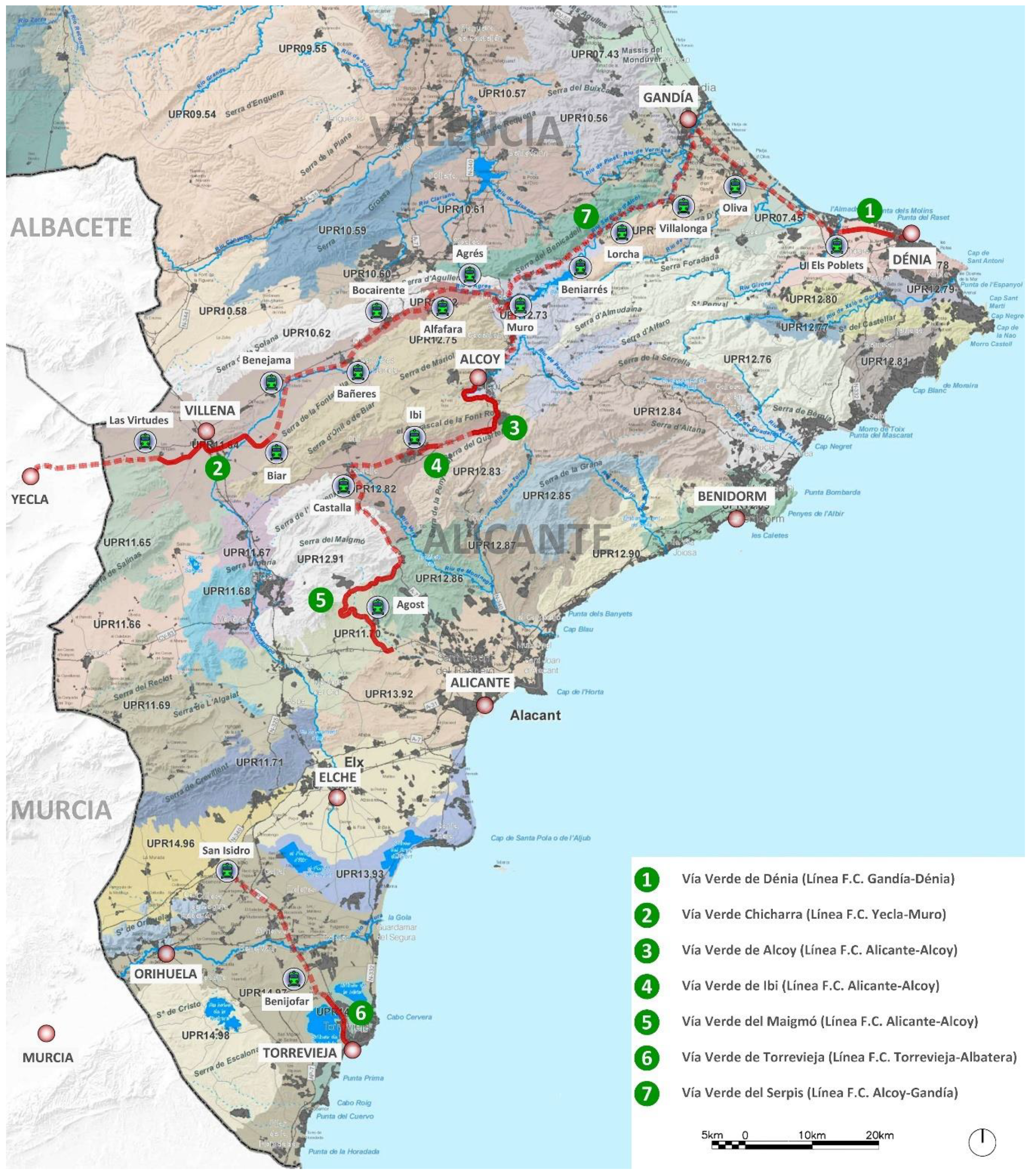

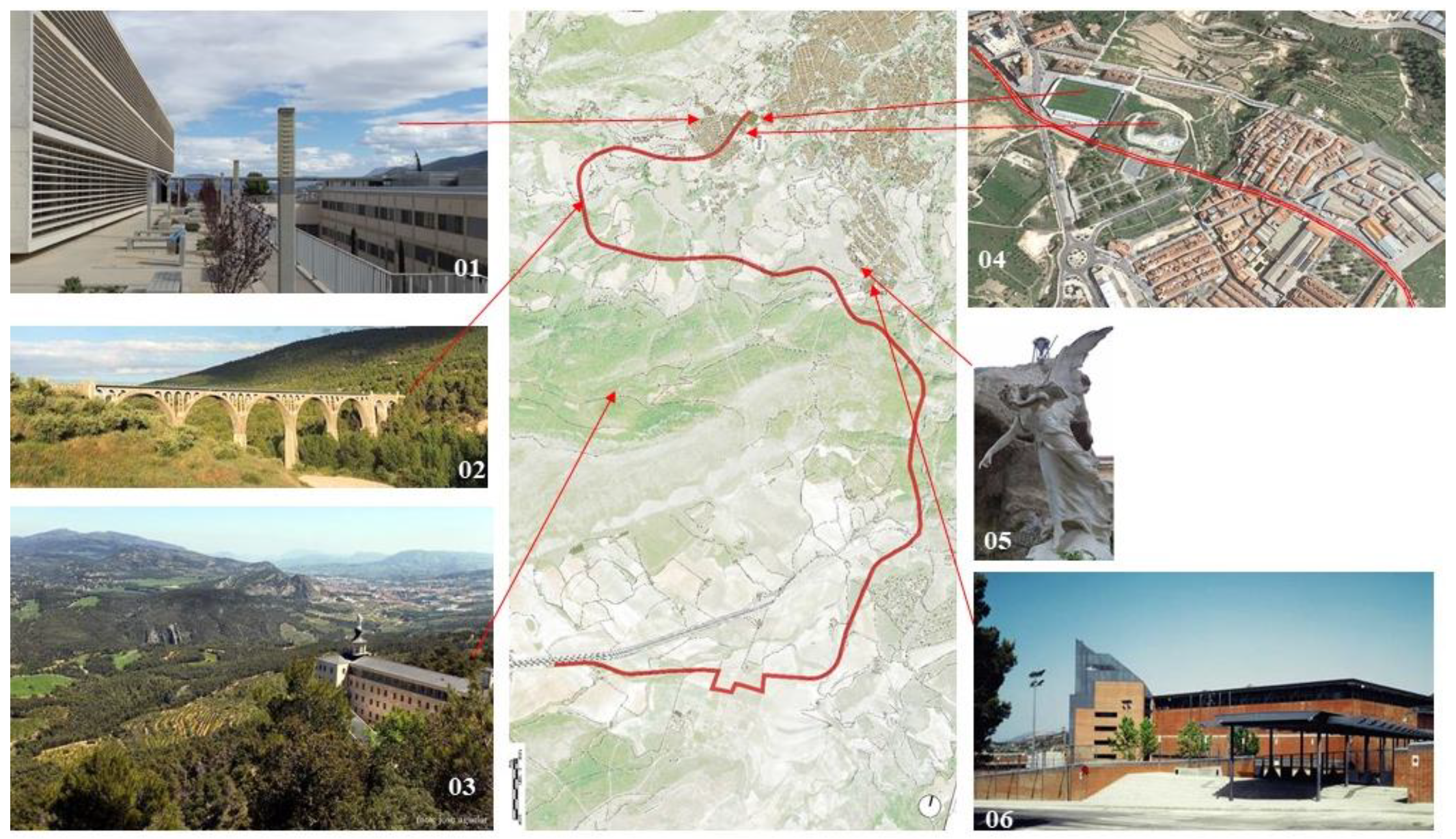
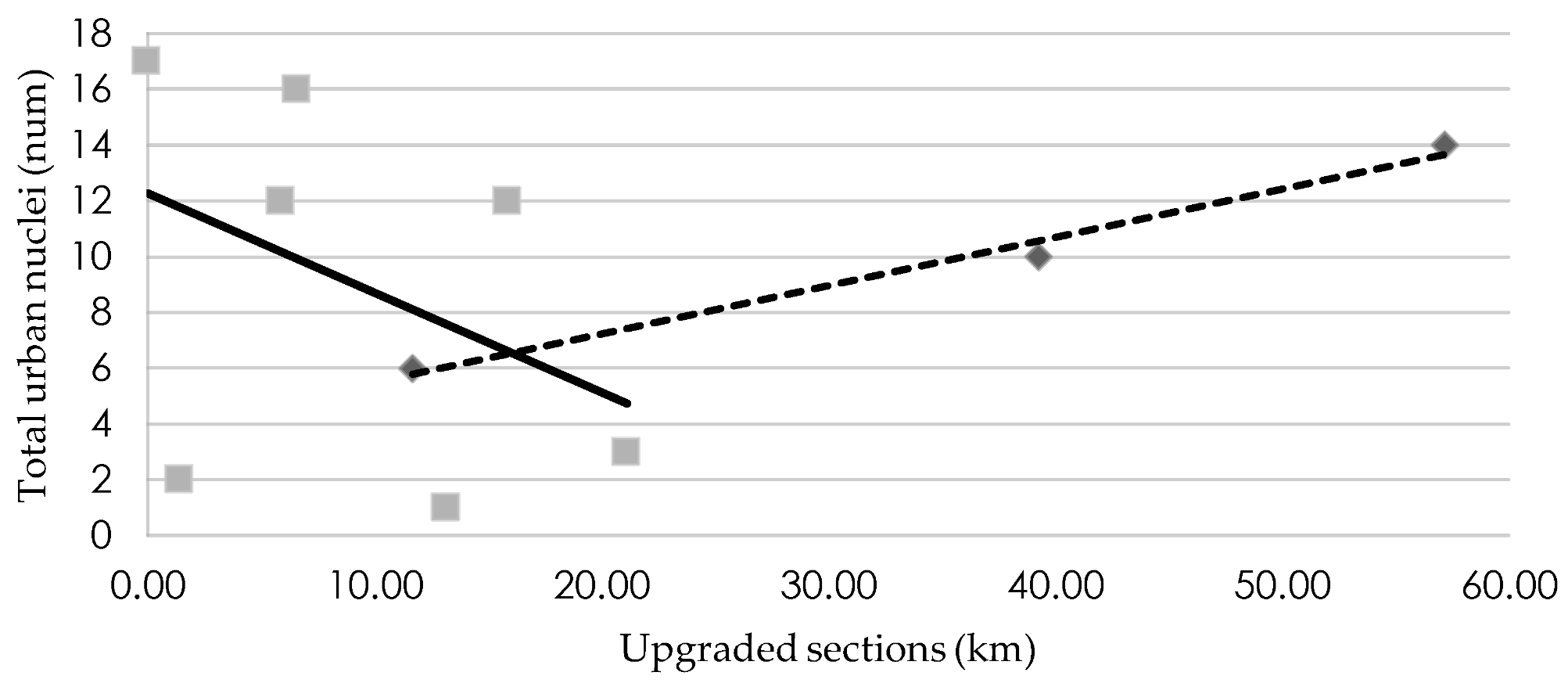
| Autonomous Community | Province | Surface (km2) | Population Density (inhab/km2) | No. Stretches of Refurbished Greenways (Vías Verdes) | Total Refurbished km |
|---|---|---|---|---|---|
| Cataluña | Girona | 5910 | 128.9 | 3 | |
| Barcelona | 7726 | 721.0 | 2 | 166.64 | |
| Tarragona | 6303 | 125.8 | 2 | ||
| Valencian Community | Castellón | 6612 | 87.3 | 2 | |
| Valencia | 10,763 | 239.6 | 2 | 162.88 | |
| Alicante | 5816 | 334.2 | 6 | ||
| Murcia Region | Murcia | 11,313 | 129.3 | 4 | 145.72 |
| Andalucía* | Almería | 8774 | 79.7 | 5 | |
| Granada | 12,531 | 72.41 | 3 | 72.31 | |
| Málaga | 7308 | 223.13 | 1 |
| Autonomous Community | Province | Id. Greenway or Vía verde | Stretch | Prov. Total km |
|---|---|---|---|---|
| km | ||||
| Cataluña | Girona | VV del Carrilet (Girona-Sant Feliu de Guixols) | 39.28 | 108.15 |
| VV del Carrilet (Olot-Girona) | 57.19 | |||
| VV del Ferro i del Carbo | 11.68 | |||
| Barcelona | VV del Nicolau (el Bergueda) | 8.22 | 9.73 | |
| VV del Vallés | 1.52 | |||
| Tarragona | VV del Baix Ebre | 25.31 | 48.76 | |
| VV de Terra Alta | 23.45 | |||
| Comunidad Valenciana | Castellón de la Plana | VV del Mar | 5.70 | 74.69 |
| VV de Ojos Negros I | 68.99 | |||
| Valencia | VV Xurra | 16.18 | 24.04 | |
| VV de la Safor | 7.86 | |||
| Alicante | VV de Denia | 5.91 | 64.15 | |
| VV de Alcoi | 13.19 | |||
| VV de Ibi (Tramo FC Alicante-Alcoy) | 1.41 | |||
| VV del Xixarra (Las Virtudes-Villena-Biar) | 15.88 | |||
| VV del Maigmó | 21.14 | |||
| VV de Torrevieja | 6.61 | |||
| Región de Murcia | Murcia | VV del Noroeste | 79.88 | 145.72 |
| VV Cartagena-Totana | 50.06 | |||
| VV la Pinilla-Mazarron | 13.82 | |||
| VV Barrio del Peral | 1.96 | |||
| Andalucía | Almería | VV de Lucainena de las Torres | 4.98 | 53.82 |
| VV de Almanzora (Tramo del Hierro) | 11.92 | |||
| VV de Almanzora (Alcontar-Olula) | 22.09 | |||
| VV de Almanzora (Tramo de Olula del Río) | 1.55 | |||
| VV de Almanzora (Tramo Huercal-Overa) | 13.28 | |||
| Granada | VV de Sierra Nevada | 1.66 | 17.68 | |
| VV de la Sierra de Baza | 9.41 | |||
| VV de la Sierra de Baza (ampliación) | 6.61 | |||
| Málaga | VV del Rincón de la Victoria | 0.81 | 0.81 |
| Province | Id. Greenway or Vía verde | Water | Forest | Disperse Woodland | Shabby Woodland | Artificial Soil | Agricultural Crops | Treeless | |||||||
|---|---|---|---|---|---|---|---|---|---|---|---|---|---|---|---|
| km | % | km | % | km | % | km | % | km | % | km | % | km | % | ||
| Girona | Carrilet II (Girona-St.Feliu Guixols) | - | - | 8.65 | 22.0% | - | - | - | - | 7.32 | 18.6% | 22.88 | 58.2% | 0.43 | 1.1% |
| Carrilet I (Olot-Girona) | 0.09 | 0.2% | 23.39 | 40.9% | - | - | - | - | 7.84 | 13.7% | 25.86 | 45.2% | 0.02 | 0.0% | |
| Ferro i del Carbo | - | - | 4.23 | 36.2% | - | - | - | - | 2.10 | 18.0% | 5.35 | 45.8% | - | - | |
| Barcelona | El Nicolau (El Bergueda) | - | - | 5.01 | 60.9% | - | - | - | - | 1.39 | 16.9% | 1.67 | 20.3% | 0.15 | 1.8% |
| El Vallés | - | - | 1.09 | 72.0% | - | - | - | - | 0.16 | 10.6% | 0.00 | 0.2% | 0.26 | 17.2% | |
| Tarragona | Baix Ebre | - | - | 7.78 | 30.7% | - | - | - | - | 1.24 | 4.9% | 14.20 | 56.1% | 2.09 | 8.3% |
| Terra Alta | - | - | 11.45 | 48.8% | - | - | 0.10 | 0.4% | 0.17 | 0.7% | 11.51 | 49.1% | 0.21 | 0.9% | |
| Castellón de la Plana | Mar | - | - | 3.48 | 60.9% | - | - | - | - | 1.88 | 33.0% | 0.34 | 6.0% | - | - |
| Ojos Negros I | 6.44 | 9.3% | 11.59 | 16.8% | - | - | 0.09 | 0.1% | 4.19 | 6.1% | 32.65 | 47.3% | 14.03 | 20.3% | |
| Valencia | Xurra | 0.03 | 0.2% | - | - | - | - | - | - | 5.28 | 32.6% | 10.87 | 67.1% | - | - |
| La Safor | 0.09 | 1.1% | - | - | - | - | - | - | 1.87 | 23.7% | 5.90 | 75.1% | - | - | |
| Alicante | Denia | 0.12 | 2.0% | - | - | - | - | - | - | - | - | 5.79 | 98.0% | - | - |
| Alcoi | - | - | 6.13 | 46.5% | - | - | 0.22 | 1.6% | 1.59 | 12.0% | 4.59 | 34.8% | 0.67 | 5.1% | |
| Ibi (FC Alicante-Alcoy) | - | - | - | - | - | - | - | - | - | - | 1.41 | 99.9% | - | - | |
| Xixarra II (Las Virtudes-Villena - Biar) | 0.05 | 0.3% | 0.33 | 2.0% | - | - | 0.12 | 0.8% | 2.27 | 14.3% | 11.32 | 71.3% | 1.79 | 11.3% | |
| Maigmó | - | - | 1.39 | 6.6% | 0.28 | 1.3% | 0.15 | 0.7% | 0.56 | 2.6% | 10.26 | 48.5% | 8.51 | 40.2% | |
| Torrevieja | - | - | - | - | - | - | - | - | 3.19 | 48.3% | 1.54 | 23.2% | 1.88 | 28.5% | |
| Murcia | Noroeste | 0.94 | 1.2% | 5.22 | 6.5% | - | - | - | - | 6.26 | 7.8% | 52.82 | 66.1% | 14.63 | 18.3% |
| Cartagena-Totana | - | - | 0.06 | 0.1% | - | - | - | - | 2.33 | 4.7% | 43.40 | 86.7% | 4.27 | 8.5% | |
| Pinilla-Mazarron | - | - | - | - | - | - | - | - | - | - | 9.17 | 66.4% | 4.65 | 33.6% | |
| Barrio del Peral | - | - | - | - | - | - | - | - | 1.55 | 79.4% | 0.40 | 20.6% | - | - | |
| Almería | Lucainena de las Torres | 0.07 | 1.3% | - | - | - | - | - | - | - | - | 1.92 | 38.6% | 2.99 | 60.1% |
| Almanzora (Tramo del Hierro) | 0.19 | 1.6% | 0.19 | 1.6% | - | - | 0.32 | 2.6% | 0.41 | 3.4% | 7.07 | 59.3% | 3.75 | 31.5% | |
| Almanzora (Alcontar-Olula) | 0.11 | 0.5% | 0.03 | 0.1% | - | - | - | - | 1.61 | 7.3% | 12.88 | 58.3% | 7.47 | 33.8% | |
| Almanzora (Olula del Río) | - | - | - | - | - | - | - | 0.48 | 30.8% | 1.07 | 69.2% | - | - | ||
| Almanzora (Huercal-Overa) | 0.11 | 0.9% | - | - | - | - | - | - | 0.05 | 0.3% | 12.34 | 92.9% | 0.79 | 5.9% | |
| Granada | Sierra Nevada | - | - | 0.25 | 15.0% | - | - | - | - | - | - | 0.77 | 46.5% | 0.64 | 38.5% |
| Sierra de Baza | - | - | - | - | - | - | - | - | 1.66 | 17.6% | 4.39 | 46.7% | 3.36 | 35.7% | |
| Sierra de Baza (Ampliación) | - | - | 0.31 | 4.7% | - | - | - | - | 0.19 | 2.9% | 6.07 | 91.8% | 0.04 | 0.5% | |
| Málaga | Rincón de la Victoria | - | - | - | - | - | - | - | - | 0.79 | 97.9% | - | - | 0.02 | 2.1% |
| Vía Verde | Total length Railtrack | Upgraded Sections | Total Urban Nuclei | Total Inhabitants | |
|---|---|---|---|---|---|
| km | km | num | |||
| Girona | Carrilet I | 57.19 | 57.19 | 14 | 172,633 |
| Carrilet II | 39.28 | 39.28 | 10 | 44,473 | |
| El Ferro | 15.00 | 11.68 | 6 | 14,554 | |
| Alicante | Denia | 30.77 | 5.91 | 12 | 70,643 |
| Alcoi | 64.58 | 13.19 | 1 | 58,977 | |
| Ibi | 1.41 | 2 | 31,201 | ||
| Maigmó | 21.14 | 3 | 13,056 | ||
| Xixarra I | 53.35 | 0 | 17 | 90,936 | |
| Xixarra II | 72.64 | 15.88 | 12 | 98,649 | |
| Torrevieja | 26.00 | 6.61 | 16 | 149,873 | |
| Keywords: | Carrilet I: Carrilet (Olot-Girona) | VV Ferro: Vía Verde del Ferro I del Carbó | |||
| Carilet II: Carrilet (Girona-S. Feliú de Gixols) | VV Ibi: Vía Verde FC Alicante-Alcoi | ||||
| Xixarra I: V.V. Xixarra (Alcoi-Gandía) | Xixarra II: V.V Xixarra (las Virtudes-Villena-Biar) | ||||
| A | B | C | D | E | |||||||||||||||||
|---|---|---|---|---|---|---|---|---|---|---|---|---|---|---|---|---|---|---|---|---|---|
| 0–200 m | 200–750 m | 750–2000 m | 2000–4000 m | + 4000 m | |||||||||||||||||
| Via Verde | Urban nuclei | Population | Urban nuclei | Population | Urban nuclei | Population | Urban nuclei | Population | Urban nuclei | Population | |||||||||||
| N | % | hab | % | N | % | hab | % | N | % | hab | % | N | % | hab | % | N | % | hab | % | ||
| Girona | Carrilet I | 11 | 79 | 168,848 | 98 | 0 | - | 3 | 21 | 3785 | 2 | 0 | 0 | 0 | - | ||||||
| Carrilet II | 4 | 40 | 28,328 | 64 | 2 | 20 | 6167 | 14 | 0 | - | 4 | 40 | 9978 | 22 | 0 | 0 | - | ||||
| El Ferro | 4 | 67 | 12,454 | 86 | 0 | - | 2 | 33 | 2100 | 14 | 0 | 0 | 0 | - | |||||||
| Alicante | Denia | 4 | 33 | 50,290 | 71 | 2 | 17 | 6612 | 9 | 4 | 33 | 7594 | 11 | 1 | 8 | 6147 | 9 | 0 | 0 | - | |
| Alcoi | 1 | 100 | 58,977 | 100 | 0 | - | 0 | - | 0 | - | 0 | 0 | - | ||||||||
| Ibi | 2 | 100 | 31,201 | 100 | 0 | - | 0 | - | 0 | - | 0 | 0 | - | ||||||||
| Maigmó | 0 | - | 0 | - | 1 | 33 | 4017 | 31 | 2 | 67 | 9039 | 69 | 0 | 0 | - | ||||||
| Xixarra I | 9 | 53 | 80,193 | 88 | 0 | - | 8 | 47 | 10,663 | 12 | 0 | - | 0 | 0 | - | ||||||
| Xixarra II | 5 | 42 | 81,350 | 82 | 4 | 33 | 11,794 | 12 | 3 | 25 | 5,505 | 6 | 0 | - | 0 | 0 | - | ||||
| Torrevieja | 2 | 13 | 62,935 | 42 | 0 | - | 6 | 38 | 35,236 | 24 | 5 | 31 | 25,190 | 17 | 3 | 19 | 26,512 | 18 | |||
| Keywords: | Carrilet I: Carrilet (Olot -Girona) | VV Ferro: Vía Verde del Ferro I del Carbó | |||||||||||||||||||
| Carrilet II: Carrilet (Girona-S. Feliú de Gixols) | VV Ibi: Vía Verde FC Alicante-Alcoi | ||||||||||||||||||||
| Xixarra I: V.V. Xixarra (Alcoi-Gandía) | Xixarra II: V.V Xixarra (las Virtudes-Villena-Biar) | ||||||||||||||||||||
| Vía Verde | Refurbished km | WIKILOC |
|---|---|---|
| Number of Routes | ||
| VV del Carrilet (Olot-Girona) | 57.19 | 4219 |
| VV del Carrilet (Girona-Sant Feliu de Guixols) | 39.28 | 1879 |
| VV del Ferro i del Carbo | 11.68 | 2696 |
| VV de Denia | 5.91 | 42,584 |
| VV de Alcoi | 13.19 | 44,292 |
| VV de Ibi (Tramo FC Alicante-Alcoy) | 1.41 | 46,441 |
| VV del Maigmó | 21.14 | 45,106 |
| VV del Xixarra (Las Virtudes-Villena-Biar) | 15.88 | 42,524 |
| VV de Torrevieja | 6.61 | 46,425 |
© 2020 by the authors. Licensee MDPI, Basel, Switzerland. This article is an open access article distributed under the terms and conditions of the Creative Commons Attribution (CC BY) license (http://creativecommons.org/licenses/by/4.0/).
Share and Cite
García-Mayor, C.; Martí, P.; Castaño, M.; Bernabeu-Bautista, Á. The Unexploited Potential of Converting Rail Tracks to Greenways: The Spanish Vías Verdes. Sustainability 2020, 12, 881. https://doi.org/10.3390/su12030881
García-Mayor C, Martí P, Castaño M, Bernabeu-Bautista Á. The Unexploited Potential of Converting Rail Tracks to Greenways: The Spanish Vías Verdes. Sustainability. 2020; 12(3):881. https://doi.org/10.3390/su12030881
Chicago/Turabian StyleGarcía-Mayor, Clara, Pablo Martí, Manuel Castaño, and Álvaro Bernabeu-Bautista. 2020. "The Unexploited Potential of Converting Rail Tracks to Greenways: The Spanish Vías Verdes" Sustainability 12, no. 3: 881. https://doi.org/10.3390/su12030881
APA StyleGarcía-Mayor, C., Martí, P., Castaño, M., & Bernabeu-Bautista, Á. (2020). The Unexploited Potential of Converting Rail Tracks to Greenways: The Spanish Vías Verdes. Sustainability, 12(3), 881. https://doi.org/10.3390/su12030881







